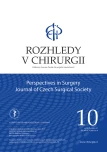-
Medical journals
- Career
Concomitant embolism in the subclavian and pulmonary artery
Authors: R. Špunda 1; M. Špaček 1; R. Šachl 2; L. Lambert 3; S. Heller 4; J. Lindner 1
Authors‘ workplace: II. chirurgická klinika kardiovaskulární chirurgie, Všeobecná fakultní nemocnice a 1. lékařská fakulta Univerzity Karlovy, Praha 1; Klinika anesteziologie, resuscitace a intenzivní medicíny, Všeobecná fakultní nemocnice a 1. lékařská fakulta Univerzity Karlovy, Praha 2; Radiologická klinika, Všeobecná fakultní nemocnice a 1. lékařská fakulta Univerzity Karlovy, Praha 3; II. interní klinika – klinika kardiologie a angiologie, Všeobecná fakultní nemocnice a 1. lékařská fakulta Univerzity Karlovy, Praha 4
Published in: Rozhl. Chir., 2018, roč. 97, č. 10, s. 478-481.
Category: Case Report
Overview
Introduction:
Pulmonary embolism is a life-threatening condition that causes obstruction of the pulmonary arteries by an embolus, most often originating from the venous system of the lower limbs or pelvic veins. Depending on the extent of the embolism, an acute right-sided heart failure may result, with subsequent death. Paradoxical embolism is a condition in which a venous thrombus is embolized into the systemic circulation arteries by a right-to-left heart shunt. This condition most commonly occurs in the interatrial septum. The aim of treatment for pulmonary embolism is to remove the obstruction of the lung. Depending on the extent of the embolism and the patient’s hemodynamic status, thrombolytic or surgical treatment can be chosen. Thrombolytic therapy has become the basis of treatment for all types of acute pulmonary embolism. Currently, open surgery is indicated in hemodynamically unstable patients with massive pulmonary embolism, and increasingly frequently in submassive embolism where thrombolytic therapy is not effective or contraindicated.
Case report:
The case report describes a less common condition of pulmonary and concurrently systemic embolization in the subclavian artery. Thrombolytic therapy was contraindicated in this case due to the high risk of secondary embolism to the brain. Surgical embolectomy was performed from the pulmonary arteries simultaneously with direct embolectomy from the subclavian and brachiocephalic artery. The surgical management of acute pulmonary embolism is a suitable method of treatment for both massive pulmonary embolism where the procedure is performed as a life-saving indication, and submassive embolism where less invasive treatment would not be effective.
Conclusion:
Direct embolectomy of subclavian and brachiocephalic artery is associated with minimal risk of iatrogenic embolism into the arteries supplying the brain compared to indirect embolectomy performed from the cubital or brachial artery.
Key words:
embolism − paradoxical embolization – embolectomy − foramen ovale − stroke
Sources
- Cooley DA, Beall AC. A technic of pulmonary embolectomy using temporary cardiopulmonary bypass: clinical and experimental considerations. Bull Soc Int Chir 1962;21 : 278−89.
- Widimský J, Malý J, Eliáš P, et al. Doporučení diagnostiky, léčby a prevence plicní embolie, verze 2007. Cor Vasa 2008;50(Suppl):1S25–1S72.
- Marshall PS, Mathews KS, Siegel MD. Diagnosis and management of life-threatening pulmonary embolism, J Intensive Care Med 2011;26 : 275−94.
- P. Němec B, Uchytil J, Černý J, et al. Chirurgická léčba plicní embolie. Vnitř Lék 2009;55 : 779−82.
- Leacche M, Unic D, Goldhaber SZ, et al. Modern surgical treatment of massive pulmonary embolism: results in 47 consecutive patients after rapid diagnosis and aggressive surgical approach. J Thorac Cardiovasc Surg 2005;129 : 1018–13.
- Digonnet A, Moya-Plana A, Aubert S, et al. Acute pulmonary embolism: a current surgical approach. Interact Cardiovasc Thorac Surg 2007;6 : 27−9.
- Torbicki A, Galié N, Covezzoli A, et al. Right heart thrombi in pulmonary embolism. Results from the international cooperative pulmonary embolism registry. J Am Coll Cardiol 2003;41 : 2245–51.
- Chartier L, Béra J, Delomez M, et al. Free-floating thrombi in the right heart: diagnosis, management, and prognostic indexes in 38 consecutive patients. Circulation 1999;99 : 2779–83.
- Myers PO, Fassa AA, Panos A, et al. Life-threatening pulmonary embolism associated with a thrombus straddling a patent foramen ovale: report of a case. J Card Surg 2008;23 : 376–8.
- Mokráček A, Vambera M, Šulda M, et al. Akutní masivní plicní embolie – indikace k tromboembolektomii. Vnitř Lék 2005;51 : 734–9.
- Fogarty TJ, Daily PO, Shumway NE, et al. Experience with balloon catheter technic for arterial embolectomy. Am J Surg 1971;122 : 231−7.
- Azari A, Beheshti AT, Moravvej Z, et al. Surgical embolectomy versus thrombolytic therapy in the management of acute massive pulmonary embolism: Short and long-term prognosis. Heart Lung 2015;44 : 335–9.
Labels
Surgery Orthopaedics Trauma surgery
Article was published inPerspectives in Surgery

2018 Issue 10-
All articles in this issue
- Treatment strategies for patients with colorectal carcinoma and synchronous liver metastases
- Current possibilities of dural reconstruction in neurosurgery
- Intraperitoneal onlay mesh – an analysis of the patient‘s cohort
- Influence of overweight and obesity on complications in colorectal surgery
- Laparoscopic cholecystectomy in patient with situs viscerum inversus totalis and gallbladder empyema – a case report
- Spontaneous bilateral rupture of patellar ligament
- Concomitant embolism in the subclavian and pulmonary artery
- Perspectives in Surgery
- Journal archive
- Current issue
- Online only
- About the journal
Most read in this issue- Spontaneous bilateral rupture of patellar ligament
- Current possibilities of dural reconstruction in neurosurgery
- Intraperitoneal onlay mesh – an analysis of the patient‘s cohort
- Concomitant embolism in the subclavian and pulmonary artery
Login#ADS_BOTTOM_SCRIPTS#Forgotten passwordEnter the email address that you registered with. We will send you instructions on how to set a new password.
- Career

